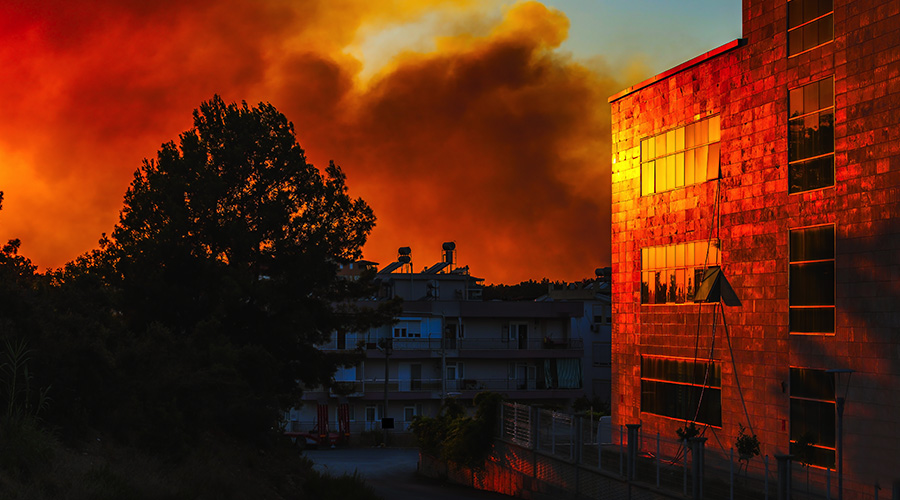What is Photoluminescent Marking?
Photoluminescent products — for pathway marking and emergency signage — are gaining popularity
with building owners and code bodies
The use of photoluminescent pathway marking has increased dramatically since the 1980s. Even so, many experts say that use of the technology is still in its infancy and the future looks brighter still. Requirements for the installation of photoluminescent pathway marking have spread from ships to aircraft to trains and, most recently, to buildings, notably in New York City. Changes in the International Building Code (IBC) will affect new high-rise buildings worldwide, while recent proposals to modify the IBC, if approved, would lead to much wider use of photoluminescent pathway marking in existing buildings. As a result, it’s worthwhile for facility executives to become more knowledgeable about photoluminescent pathway marking technology and installation.
The National Fire Protection Association’s Life Safety Code defines photoluminescence as “having the ability to store incident electromagnetic radiation typically from ambient light sources, and release it in the form of visible light.” In other words, photoluminescent material absorbs the energy provided by visible and near-visible light and then releases that energy at some later time, also in the form of light. Photoluminescent pigments first appeared in the early 1900s. However, it is only in the last 25 years that their use has spread from novelty products, like glow-in-the-dark toys, to safety products like pathway markings, exit signs and egress signage.
Pathway marking, also referred to as exit path marking, does not illuminate a space but identifies critical elements of the means of egress, such as stair treads, landings, doors and handrails. While initially conceived as a means to enable egress when smoke from a fire obscures overhead lighting and exit signs, pathway marking is also useful during a power failure, earthquake, terrorist attack, or any event that compromises lighting or signage.
Photoluminescent pathway marking is gaining wider acceptance by code bodies. New Zealand’s decision in 2007 to embrace pathway marking as equivalent to traditional overhead emergency lighting is the latest in a string of innovations in that country’s building code. This action will give rise to additional study and discussion as similar proposals are made in other countries. Given the 2009 IBC requirement to provide photoluminescent pathway marking in stairwells in new buildings, there may be facility executives who believe they should be able to install photoluminescent pathway marking in lieu of emergency lighting.
Pathway Marking Technologies
A choice has existed between electrically powered and photoluminescent pathway marking since the 1980s. On cruise ships, owners generally decided to install electrically powered pathway marking using strips of LEDs in passenger areas and photoluminescent pathway marking in crew areas. On trains, photoluminescent pathway marking has been the predominant choice. For aircraft, photoluminescent pathway marking is preferable given its lower weight and higher reliability. In buildings, the few recent regulations requiring pathway marking have generally limited it to photoluminescent technology.
The main advantage to electrically powered pathway marking is that it can be brighter than photoluminescent technology. However, that brightness is dependent on a battery, wiring and connections, which may fail to operate. Photoluminescent technology cannot fail to emit light once it has been “charged” by an ambient light source.
This is not to say that photoluminescent technology is infallible. It must be exposed to ambient light of a minimum intensity and type for a set period of time to absorb enough energy to emit useful light. Those advocating against the use of photoluminescent pathway marking worry that the signage will not be properly charged and functional if an emergency occurs immediately after occupants enter a building. However, electrically powered exit signs and emergency lighting pose a similar risk when recharging their batteries, because they may not yet be fully operational at that time.
Requirements allowing the use of photoluminescent technology have specified that it must be operational after charging for no longer than 60, 90 or 120 minutes.
Another potential point of failure is the carrier. Photoluminescent pathway marking is manufactured by casting or molding the pigment in a carrier, generally plastic. Some carriers are susceptible to degradation from ultraviolet radiation or moisture. This issue can be addressed by requiring that a product undergo testing to verify whether it will remain operational even if exposed to those environmental effects.
James D. Amy, Jr., PE, is a senior consultant for Rolf Jensen & Associates, Inc. He has more than 15 years of experience dealing with photoluminescent pathway marking systems.
Related Topics:













